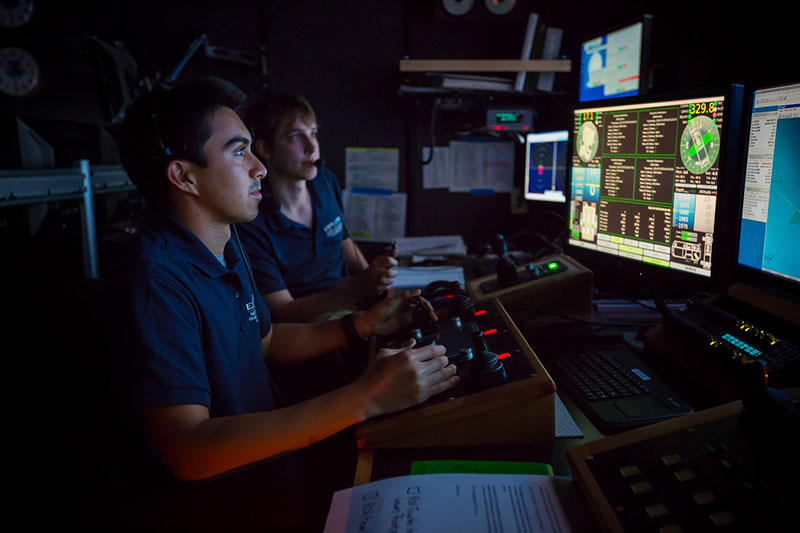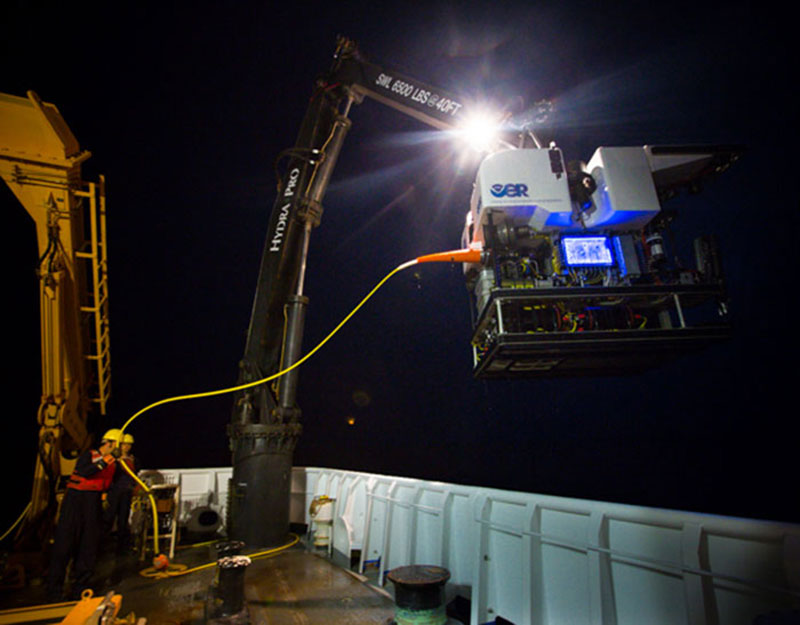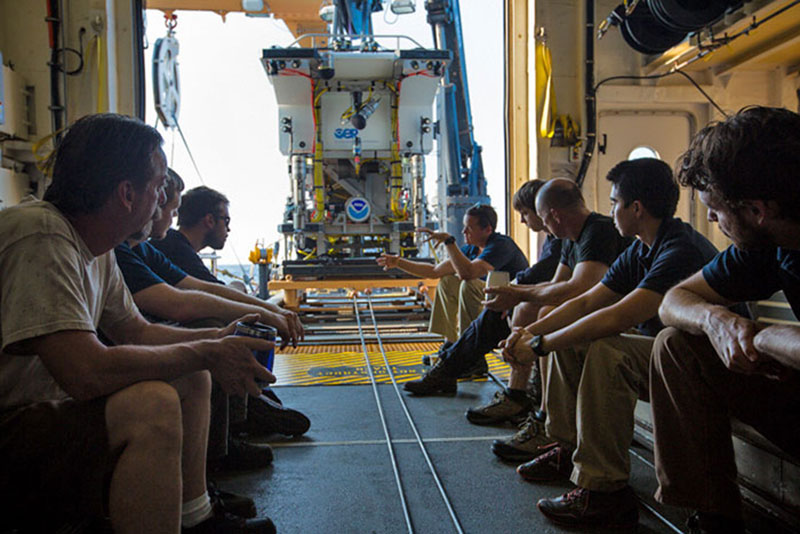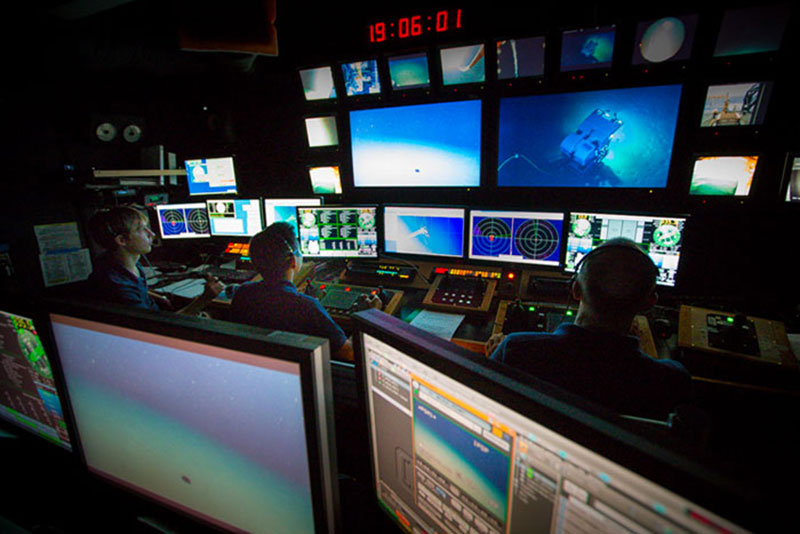
by Anthony Sylvester, Graduate Student, University of Hawaii
July 24, 2013

Anthony Sylvester (left) pilots ROV Deep Discoverer for the first time while Bobby Mohr watches from the navigator position. Image courtesy of the NOAA Office of Ocean Exploration and Research. Download larger version (jpg, 730 KB).
A hallmark of the Okeanos Explorer Program is a focus on training the next generation of explorers. NOAA’s Office of Ocean Exploration and Research conducts a thriving mentorship and training program matching early career scientists, engineers, and technicians with experts in their fields. They work side-by-side learning, innovating, and conducting explorations together with the Okeanos Explorer team.
To say that joining NOAA Ship Okeanos Explorer for the Northeast U.S. Canyons 2013 Expedition would be a new and unique experience is an understatement. This cruise has presented me with many firsts – my first time traveling to Rhode Island, my first time seeing the Atlantic Ocean, my first time at sea for more than a day, my first time working with the remotely operated vehicle (ROV) team, and soon, my first time to New York when this leg of the cruise comes to an end. I am happy to say that my experience so far has been completely positive.
Before jumping into the details about the cruise, I will first start with a little background about myself and what eventually led to this adventure. This time last year, I was finalizing my application for graduate school at the University of Hawaii at Manoa, and preparing for my final semester as an undergraduate student in Mechanical Engineering. During that final semester I connected with Dr. Brian Bingham and began working in his lab, the Field Robotics Laboratory . This is where I began to learn about underwater systems and really gained an interest in underwater technologies.

Members of the ROV team recover Deep Discoverer after a dive. Image courtesy of the NOAA Office of Ocean Exploration and Research. Download image (jpg, 75.6 KB).
One of the projects I worked on in the lab was testing software from Greensea Systems to try and find any bugs; this same software I later learned would be integrated into the control of the ROV Deep Discoverer (D2). After graduation, I accepted a position in Dr. Bingham's lab as a graduate research assistant and was later offered this opportunity to sail on the Okeanos Explorer.
Upon arriving at the Okeanos Explorer in Rhode Island, I found the weather to be much hotter and more tropical than I had expected. I carpooled with some of the crew members from the airport to the ship and quickly climbed onboard. I met many new faces and started helping members of the ROV team right away. Some of the guys were flushing the ROV motors and filling them with fresh oil. I tried to learn as much as I could about the vehicle and the cruise and tried hard to remember all the new names.
By the end of the first day, I helped to mount the motors to the ROV and then settled in my state room. At first it felt a bit overwhelming to have all of this new information dropped on me and being in a completely new working environment. I wasn't entirely sure what to expect, or what my responsibilities would be. I also couldn't shake the thought in the back of my head that I would most likely get seasick, as many had cautioned.

Dr. Brian Bingam conducts a pre-dive briefing with the ROV team. Image courtesy of the NOAA Office of Ocean Exploration and Research. Download image (jpg, 104 KB).
As the days progressed, I found myself feeling more and more comfortable with the work I was doing, the crew, and the prospect of being at sea for a period of time. We were very lucky to have calm seas at the beginning of the cruise, and I think that helped to ease the transition to living at sea.
ROV operations were very methodical and structured. Each member of the ROV team was scheduled certain watch positions each day such as working the deck, pilot, co-pilot, navigator, and winch station. This format was very helpful in learning how the vehicle works and how to properly operate it. In a short amount of time, I was working in the navigator seat, interacting with the pilots, the scientists, and the ship's bridge to coordinate where to drive the ship to keep everyone happy and keep the vehicles safe.
Eventually I had the opportunity to sit co-pilot and drive the camera sled Seirios. Shortly after, that I found myself sitting in the pilot seat driving D2! That moment felt very fulfilling – being able to operate a top-of-the-line piece of technology, thousands of feet below the ocean, in areas that have never before been seen by man. Although my time driving the ROV wasn't very long, it was definitely the highlight of the trip.

Bobby Mohr (left) and Jeff Williams (right) provide guidance during Anthony Sylvester's first experience as an ROV pilot. Image courtesy of the NOAA Office of Ocean Exploration and Research. Download image (jpg, 85.4 KB).
The cruise is nearly over and we have successfully completed all of our dives so far without any major problems. From an engineering standpoint, Deep Discoverer has met or exceeded most expectations. I am very happy that I was able to be a part of this cruise and I am sure that I'll walk away with a few new friends and some good stories to tell.
I can say that working with the ROV team and sailing on the Okeanos Explorer has been many things to me, but most of all it has been a wealth of new knowledge and an amazing experience.